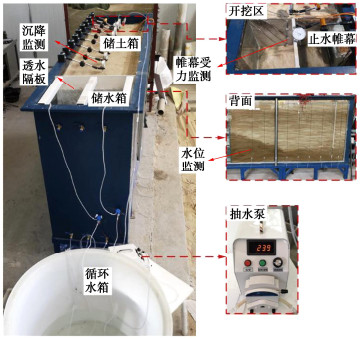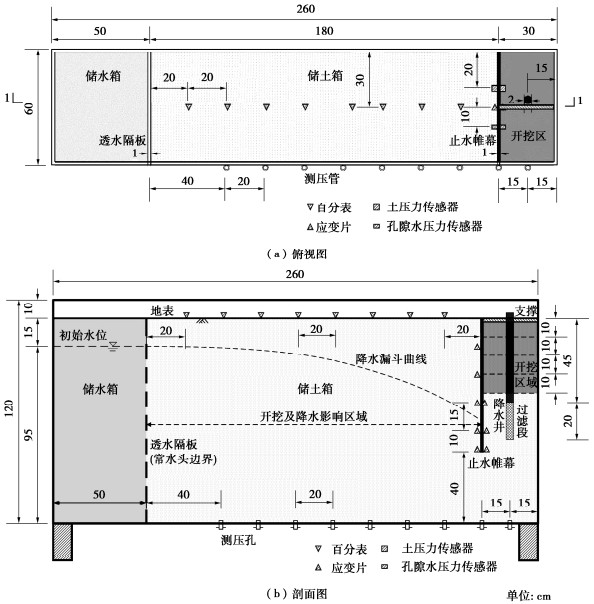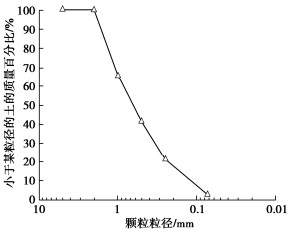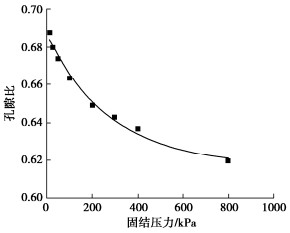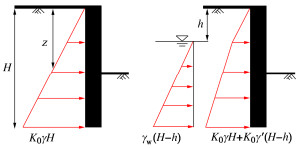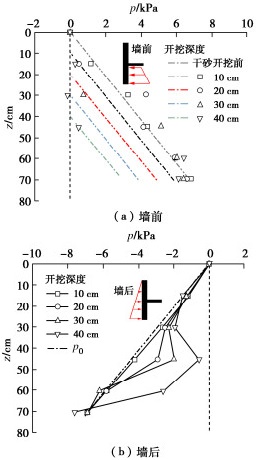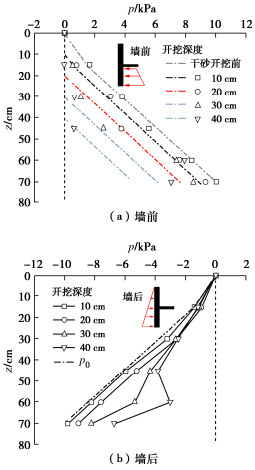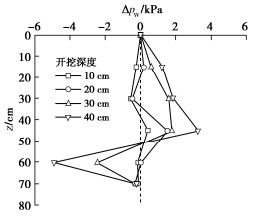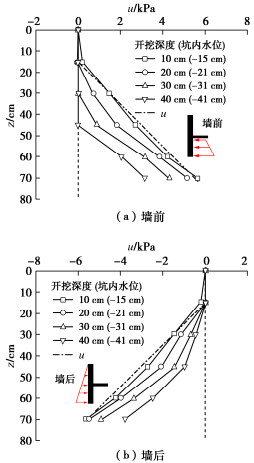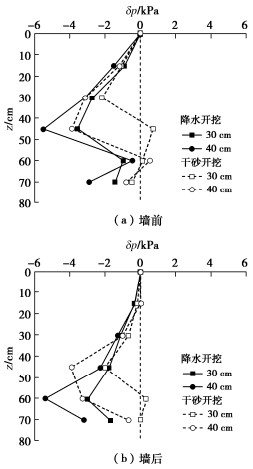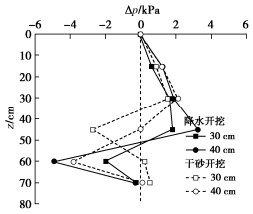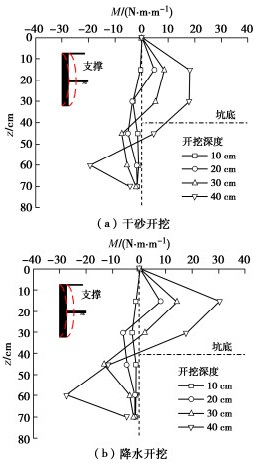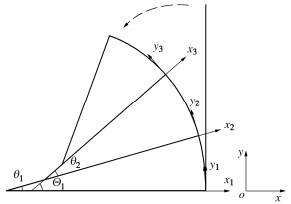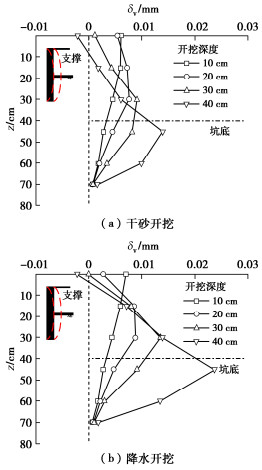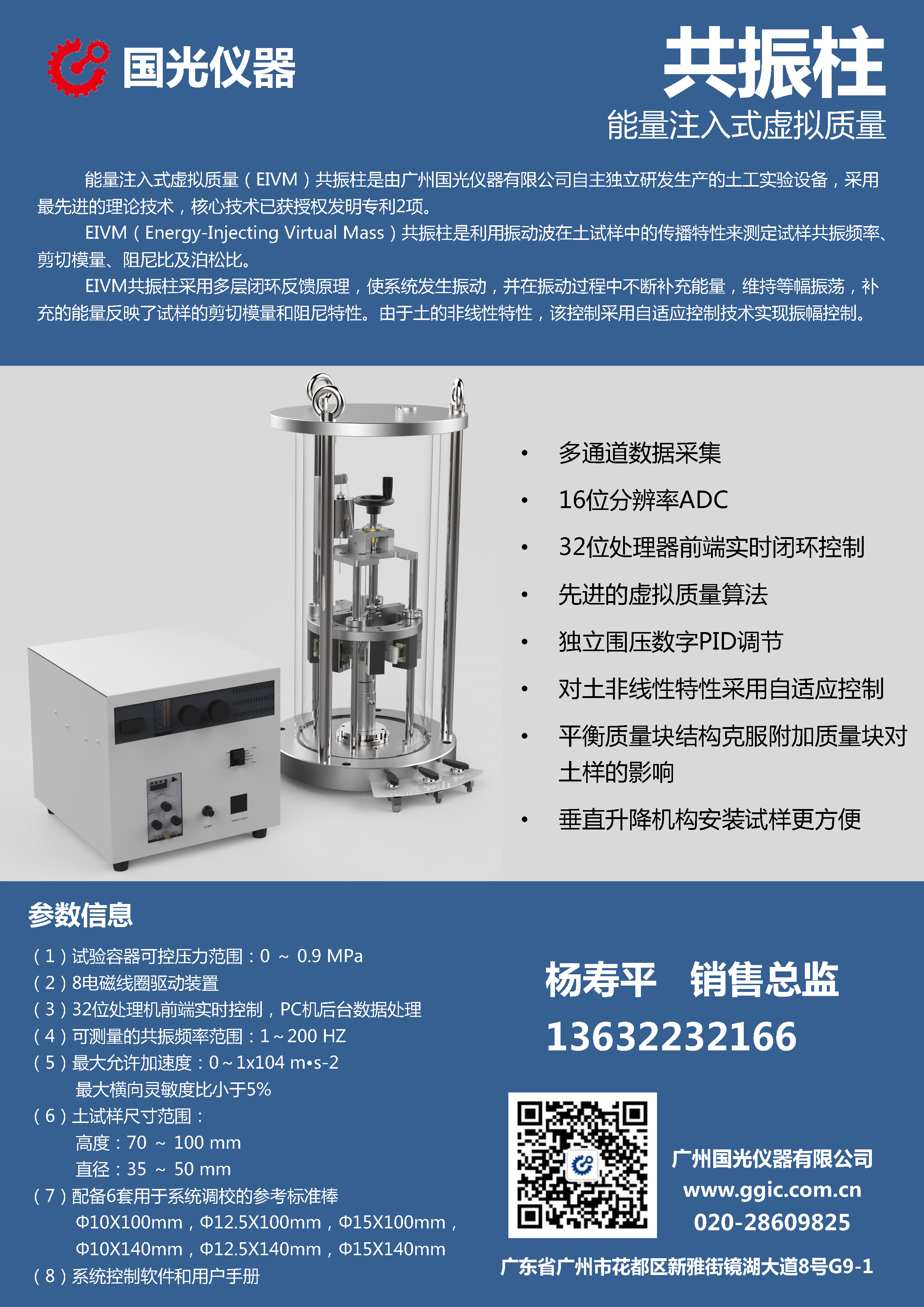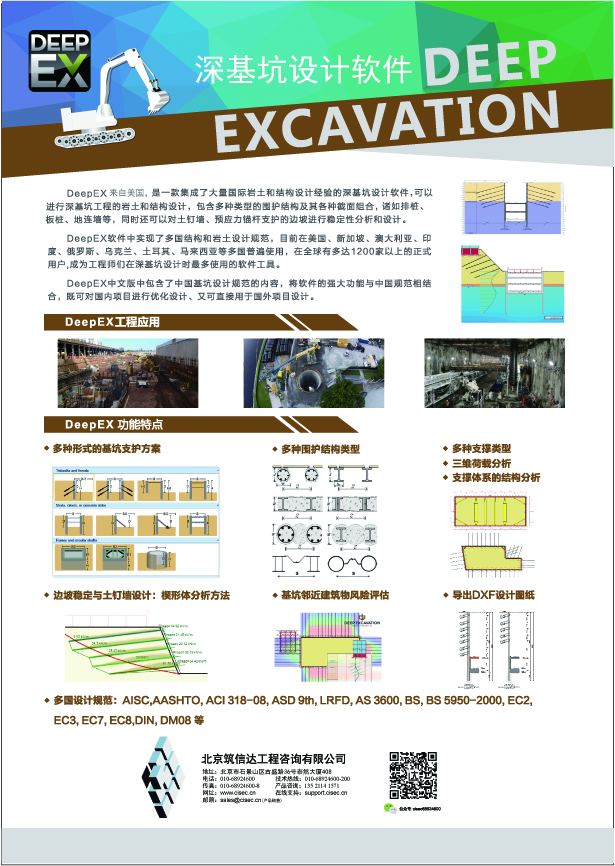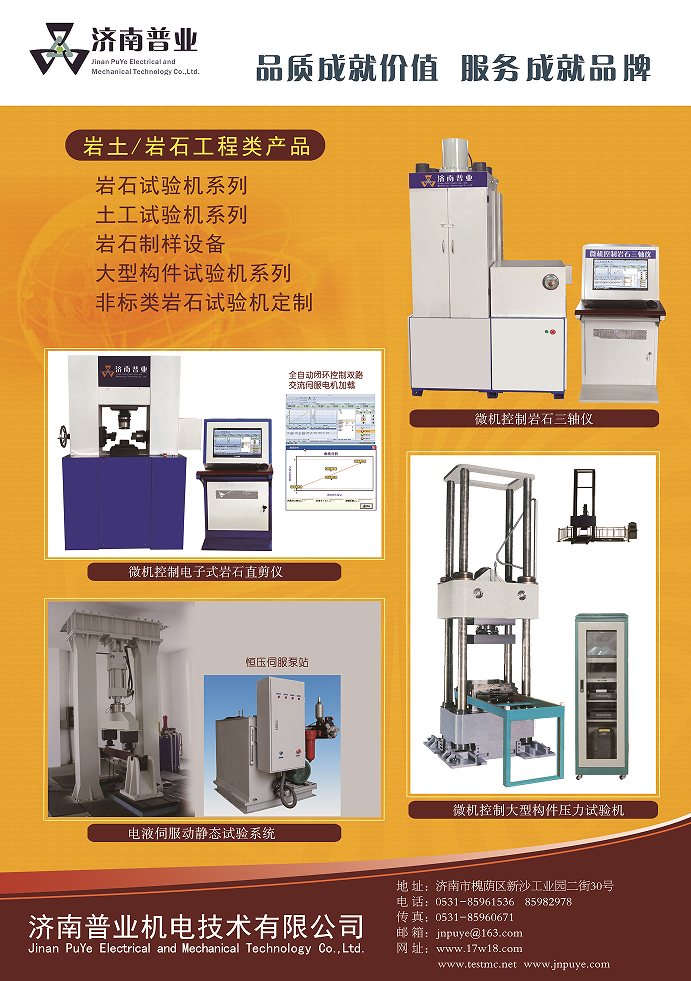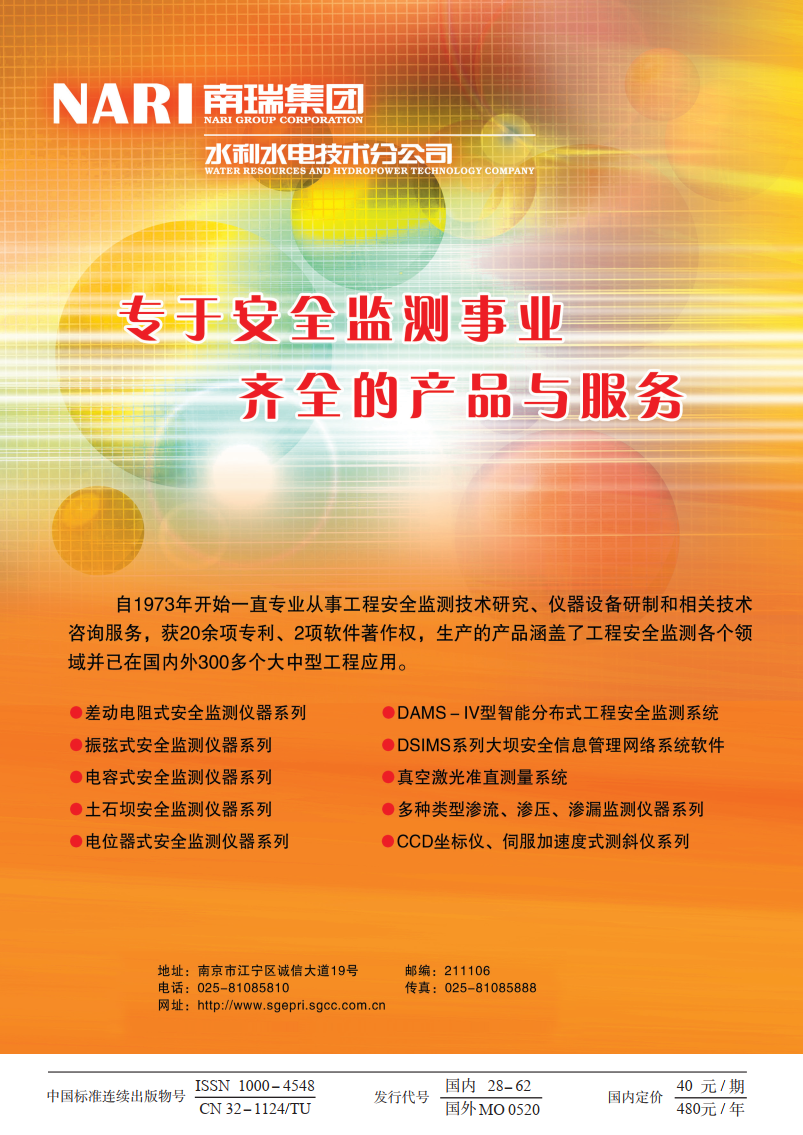Model tests on stress and deformation mechanism of diaphragm wall under combined effects of dewatering and excavation
-
摘要: 为揭示基坑降水与开挖共同作用下地连墙受力变形机制,开展了室内模型试验模拟基坑干砂开挖与降水开挖过程,采集了地连墙两侧水土压力、坑外地表沉降、地连墙弯矩及侧移等数据。通过对比不同工况条件下地连墙受力变形的变化特点及内在联系,分析了基坑降水开挖对地连墙受力变形的影响机制。试验结果表明:基坑降水与基坑开挖均会改变地连墙两侧侧向土压力分布形式,与干砂开挖相比,降水开挖共同作用时侧向土压力变化更为显著,墙前被动土压力更小,墙后侧向土压力峰值位置则有所下移,地连墙由此产生更大的弯矩值,并诱发更显著的地连墙侧移。Abstract: In order to reveal the mechanism of stress and deformation of the diaphragm wall under combined effects of dewatering and excavation, the processes of dry sand excavation and excavation with dewatering are carefully simulated by conducting a series of laboratory model tests, and the data such as pore-water and earth pressures at both sides of the diaphragm wall, settlements outside the pit, bending moments and lateral displacements of the wall are collected. By comparing the characteristics of variations and internal connections of stress and deformation of the diaphragm wall under different conditions, the mechanism of stress and deformation of the diaphragm wall caused by excavation with dewatering is analyzed. The results show that the distribution patterns of lateral earth pressures at both sides of the diaphragm wall will be changed by both dewatering and excavation. The lateral earth pressures change more significantly under the combined effects of dewatering and excavation compared with the case of dry sand excavation, there will be less passive earth pressure zone in front of the diaphragm wall, while the peak positions of lateral earth pressures behind the diaphragm wall will move down. On this occasion, the diaphragm wall will develop greater bending moments and induce more significant lateral displacements.
-
0. 引言
近年来,随着城市化的进一步加深,基坑工程的建设朝着超大、超深的方向发展[1],深基坑降水和开挖将会引起地下水渗流场、土层中应力场的变化,只有正确认识基坑降水开挖过程中地连墙的受力变形机制,才能更好地指导深基坑的设计与施工。
目前,国内外已有许多学者采用多种方法对基坑开挖条件下地表沉降、地连墙变形进行研究。马险峰等[2]以上海某超深基坑为对象开展离心模型试验,研究了超深基坑开挖过程中地下连续墙侧移、坑外地层变形等规律;陈宝国等[3]通过模型试验方法,研究了内支撑体系、地连墙和墙后土体之间的协调变形特性,得出了墙后侧向土压力、坑外地表沉降等随支撑体系调节方式的变化规律;Fan等[4]假定围护结构变形曲线为分段二次多项式,推导出任意变形模式下的地表沉降解析解。
上述研究主要集中于基坑开挖卸荷引起的基坑变形及坑外地表沉降,忽略了基坑降水疏干对基坑施工造成的影响,当前基坑降水问题的研究重点在于坑内外水位变化及其对周围环境的影响。Goh等[5]通过有限元分析评估了影响地下水位下降引起地面沉降性能的关键参数,并开发了人工神经网络模型来估计最大地面沉降;Zeng等[6]基于现场抽水试验结果,采用流固耦合数值模型模拟基坑降水试验,揭示了地下水位下降和墙体移动共同作用下的地面沉降特征。
现阶段对于基坑降水对地连墙受力及变形的研究成果较少[7-8],且现有研究重点集中于基坑降水对地连墙的受力变形研究,缺乏降水开挖共同作用对地连墙受力变形的研究,而实际施工过程中基坑降水与开挖同时进行,地连墙会受到降水疏干及开挖卸荷的共同作用影响。现有研究大多采用数值模拟方法,其在考虑土与结构相互作用时所使用的假设条件过多,准确性有待进一步验证。而模型试验方法可以更好地还原工程条件,适合进行规律性研究,故常被用于基坑降水方面的研究。Xu等[9]进行了一系列室内试验研究,研究了地连墙的埋深和抽水井的过滤段长度对地下水位变化的影响;曾超峰等[10-12]开展了室内模型试验,揭示了基坑开挖前降水引发基坑变形的机制。
综上,当前大多数研究仅考虑基坑降水或基坑开挖单独作用对坑外水位变化、地表沉降及基坑变形的影响,而针对基坑降水与开挖共同作用下地连墙受力及变形规律的研究较少。本文为揭示基坑降水与开挖共同作用下地连墙受力及变形机制,开展了模型试验研究,模拟了基坑干砂开挖与降水开挖过程,通过对比不同条件下地连墙受力及变形的联系与区别,分析了基坑开挖卸荷与降水疏干对地连墙受力及变形的影响机制。
1. 模型试验系统
1.1 工程概况
如图 1所示为南昌地铁4号线某车站基坑平面布置及模拟区示意图,车站总长238 m,标准段宽22.7 m,标准段开挖深度约16 m,端头井段开挖深度约17.2 m。开挖范围属于强透水含水层,潜水位高程为4.10~7.04 m,故布置疏干井进行潜水疏干。地连墙采用C35钢筋混凝土,厚度800 mm,深度约为28 m。
本地铁车站基坑为狭长形基坑,仅针对如图 1所示的模拟区进行研究,即疏干井J7和观测井G8所在区域进行研究。所模拟区域为狭长形基坑中间段,不受到边角效应的影响,呈现出近似于平面应变的状态,因此,本模型试验为拟三维试验。
由于本模型试验是在1g缩尺条件下进行,难以满足所有物理力学相似条件,主要控制地连墙尺寸及地连墙抗弯刚度满足相似比。根据实验室场地条件及现有模型试验[10-12]取值经验,取相似比例为1∶40。值得注意的是,模型试验目的在于定性揭露地连墙的受力变形规律研究,而非对实际工程进行定量反推预测,研究重点也并非坑后土体的沉降特征,为简化试验,不对土体进行缩尺设计。
1.2 模型箱
如图 2所示为模型试验装置实物图,试验模型箱尺寸为260 cm×60 cm×120 cm(长×宽×高),为钢制无盖长方体箱体,长度方向为透明钢化玻璃观察窗,设置一道高强度槽钢加固箱体,限制箱体侧向变形。
如图 3所示为模型试验装置示意图,左侧为储水箱,储水箱与储土箱由透水隔板隔开,储水箱侧壁贴有刻度线,通过流量可调节抽水泵动态补给储水箱,严格控制储水箱内水位动态稳定,形成常水头边界。透水隔板全断面均匀打孔,开孔率为48%,与试验土层孔隙率相似,两侧粘贴过滤网布,防止砂土流失。模型箱右侧为基坑开挖区域,开挖区平面尺寸为30 cm×60 cm,最大开挖深度为40 cm。降水方式为坑内管井井点降水,选用外径为20 mm、内径为16 mm的PVC管模拟降水,井管长度为65 cm(实际工程降水井长度为26 m,缩尺40倍),过滤段长度为20 cm(实际工程过滤段长度为8 m,缩尺40倍),为保持过滤段强度以及足够的进水面积,开孔采用“梅花桩”型错位排列,为避免土粒在进水孔内堵塞,井管外包裹一层尼龙过滤网布进行反滤处理。采用SR400箱式蠕动抽水泵进行基坑降水,通过标定实验确定抽水泵最大流速为1.63 L/min,通过预降水试验检验降水井的降水效果,证明本模型降水井与水泵共同作用可以将坑内水位降至设计深度。根据Xu等[9]在中砂中开展的类似降水试验经验,本研究取降水影响半径与开挖影响半径均为最大开挖深度的4倍以上,取180 cm。
试验监测装置包括测压管、百分表、应变片、孔隙水压力传感器(型号:金诚测试BWK-S型,量程0~10 kPa,分辨率0.1 kPa,满量程测量误差0.01 kPa)和土压力传感器(型号:金诚测试BW型,量程为0~30 kPa,分辨率为0.1 kPa,满量程测量误差为0.15 kPa),测压管与箱底测压孔连接,通过对齐管内凹液面与刻度条进行读数,可达到浮漂监测方法[11-12]相同的数据读取效果,百分表安装于基坑外土体表面及地连墙顶部,应变片、孔隙水压力传感器和土压力传感器均按照图 3所示的空间排布粘贴于有机玻璃地连墙中线处。
1.3 试验土体
试验采用福建平潭ISO标准砂,填土厚度为110 cm,颗粒级配曲线如图 4所示,土体参数如下:d60=0.90 mm,d30=0.35 mm,d10=0.13 mm,计算可得:Cu= 6.92,Cc=1.05,根据《土的工程分类标准:GB/T50145— 2007》[13],可判定该砂级配良好,根据《建筑地基基础设计规范:GB50007—2011》[14],可判定该砂属于中砂。
模型箱中砂土填筑完成后,取样开展常规土工试验[15]得到砂土土性参数(均进行3次平行试验并取平均值)。土性参数如表 1所示,其中,湿密度根据环刀法得到,含水率根据烘干法得到,相对密度根据比重瓶法得到,孔隙比根据测得的湿密度、含水率、相对密度由公式计算得到,渗透系数根据常水头法得到,砂土内摩擦角及有效内摩擦角通过三轴压缩试验得到,压缩模量根据固结试验得到(如图 5所示)。
表 1 土性参数表Table 1. Physical parameters of model soil土层 ρ0/(g·cm-3) w0/% Gs e K/(m·d-1) φ/(°) φ′/(°) Es/MPa 砂土 2.01 29.6 2.67 0.72 18.68 22.8 31.6 11.67 1.4 支护结构
本地铁车站基坑施工区土质较好,坑顶钢筋混凝土支撑间距为12 m,基坑开挖模拟区长边长度为60 cm,根据相似比计算得支撑间距应为30 cm,故于基坑长边中心位置处布设一道支撑。根据实际工程支撑截面尺寸及现有模型试验经验[16],支撑材料选用PVC管材,弹性模量为3.5 GPa,泊松比为0.38,设计PVC管支撑的截面尺寸为20 mm×20 mm,支撑布设情况如图 3(a)所示。
根据现有模型试验经验[10-12, 17],地下连续墙材料选用有机玻璃板,地连墙按照抗弯刚度等效相似原则设计,地连墙有机玻璃板厚度计算公式为
dm=dpn(1−ν2m1−ν2p⋅EpnEm)13。 (1) 式中:E为弹性模量;d为地连墙厚度;ν为泊松比;下标p表示原型值;n为相似比(1∶40);下标m表示整体相似分析模型值。
实际工程中地下连续墙厚度为800 mm,长度为28 m,钢筋混凝土弹性模量为35 GPa,泊松比为0.17。本试验中,地连墙采用有机玻璃模拟,其弹性模量为3.37 GPa,泊松比为0.25,将上述参数代入式(1)中,可得有机玻璃板厚度为12 mm,深度为70 cm。
1.5 试验工况及步骤
如表 2所示,开展2个工况的模型试验,工况Ⅰ为降水开挖试验,降水开挖交替进行,先降水后开挖;工况Ⅱ为干砂开挖试验,分4层开挖。根据曾超峰等[10]在粗砂中进行的模型试验经验,当模型稳定降水10 min后,模型箱内部水位达到稳定、地表沉降和地连墙侧移达到稳定状态,故本模型试验每一降水、开挖步骤均稳定30 min。
表 2 模型试验工况Table 2. Programmes of model tests工况 开挖深度/cm 降水后水位/cm Ⅰ降水开挖 10,20,30,40 -15,-21,-31,-41 Ⅱ干砂开挖 10,20,30,40 — 注:初始地下水位为-15 cm,每层开挖前,将坑内地下水位降至开挖深度以下1 cm处。 以工况Ⅰ降水开挖试验为例,各工况试验均进行3次平行试验以减少试验误差,试验步骤如下。
(1)试验准备工作
首先对模型箱进行密封性试验,确保模型箱未出现渗水情况,将透水隔板和地连墙安装至设计位置,并在地连墙两侧用硬塑料薄膜做密封处理,砂土采用人工砂雨法填筑,控制砂土落距500 mm,落砂速度约120 g/s,每层铺约50 mm直至达到需要高度,填土过程中严格控制填土压实效果。当地连墙两侧同步填砂至地表以下3 cm时,架设支撑,继续填砂至地表高度。将各监测装置安装至设计位置,归零备用。
(2)注水加压,自重固结
连接水循环系统,调节供水蠕动泵转速使储水箱水头稳定在初始水位处,地下水流通过透水隔板进入储土箱,至水头达到初始水位处,停止注水,待各测压管水头稳定,可认为土层浸润饱和,静置24 h,待土层完成固结沉降,补充填土至设定标高。
(3)降水开挖试验
采用分层开挖的方式进行基坑开挖,各层开挖深度均为10 cm。本模型试验采用人工开挖,开挖前,记录各测压管读数为初始地下水位,维持储水箱内水位始终保持在-15 cm处,开启数据采集系统,通过抽水泵进行基坑降水,遵循“先降水,后开挖”的原则,降水至各开挖层低标高以下1 cm处,静止30 min,记录各监测装置读数,开挖至设定标高,静置30 min,记录各监测装置读数,重复上述过程,直至试验结束。
工况Ⅱ干砂开挖试验与上述步骤相似,区别在于干砂开挖试验不进行注水加压及基坑降水步骤。
2. 试验结果验证
Clough等[18]提出了基坑开挖“凹陷”型地表沉降经验曲线,可预测墙后不同距离处的地表沉降,Hsieh等[19]对地表沉降预测经验曲线进行了修正,并对沉降影响区域进行了划分。图 6为降水开挖与干砂开挖地表沉降归一化曲线与经验曲线对比图,其中δ为墙后任意点处地表沉降,δmax为墙后最大地表沉降,d为坑外测点与地连墙距离,Hmax为基坑开挖深度,取开挖至30 cm处结果进行验证。可以看出,模型试验结果与经验曲线吻合较好,干砂开挖工况下地表沉降影响范围与Clough经验曲线拟合效果更好;降水开挖工况下地表沉降影响范围与Hsieh经验曲线拟合效果更好,但最大沉降点出现位置更远,这是由于悬挂式地连墙条件下,降水开挖导致坑外地下水位下降,使得坑外土体产生附加固结沉降,造成了更大的地表沉降值和地表沉降影响范围。
3. 地连墙受力分析
监测点布置受模型试验尺寸所限,不能对研究剖面全线监测,故仅对数据监测点采集数据进行分析。土压力盒数据是在填土完成并初始平衡后进行采集的,因此获得的土压力监测数据是以静止土压力为初始点的变化数据,值得注意的是,墙侧土压力盒所监测到的数据均为侧向总土压力变化值,故本文后续侧向土压力均指侧向总土压力。静止土压力系数可通过Jaky[20]提出的计算公式获得:
K0=1−sinφ′。 (2) 叠加试验测得的侧向土压力数据,从而得到试验过程中的侧向土压力变化规律。无地下水时,基坑开挖后地连墙受到的侧向土压力是深度的函数:
p0=K0γz(干砂开挖)。 (3) 存在地下水时,基坑降水开挖后地连墙受到的侧向土压力需要分为水位线上、下两部分进行计算。对于砂土地基而言,水位线以下侧向土压力计算一般采用水土分算:
p0=K0γh+K0γ′(z−h)+γw(z−h)(降水开挖)。 (4) 式中:φ′为土的有效内摩擦角;γ为土的天然重度;γw为水重度;γ′为土的浮重度;h为水位埋深;z为监测点埋深,0<z<H;H为地连墙埋深;K0为侧向土压力系数。计算简图见图 7。
3.1 墙前/后侧向土压力(干砂开挖)
图 8为干砂开挖墙前/后侧向土压力沿深度分布图,其中z为监测点埋深,p为监测点处侧向土压力值,正值代表测点处侧向土压力指向坑外,负值代表侧向土压力指向坑内(若不做特殊说明,下文侧土压力方向也如此规定)。由于墙前侧向土压力变化显著,而开挖面以下监测点较少,故墙前侧向土压力图像采用散点图。由图 8(a)可以看出,在开挖深度范围内,墙前侧向土压力以减小为主,并随深度的增加,墙前侧向土压力减小幅度逐渐增大,几乎减小至0 kPa,其原因是基坑开挖导致开挖深度范围内作用于地连墙的初始侧向土压力消散;在开挖深度以下,墙前侧向土压力出现了显著的增长现象,这是由于开挖深度范围内墙前侧向土压力消散,地连墙受力平衡被打破,发生挠曲变形,使得开挖深度以下墙前侧向土压力形式由静止土压力变为被动土压力。
墙后侧向土压力亦将重分布,由图 8(b)可以看出,同一埋深处随着开挖深度的增加,墙后侧向土压力减小幅度逐渐增大;不同埋深处干砂开挖墙后侧向土压力以减小为主,并且侧向土压力减小幅度呈现出先增后减的趋势,减小幅度峰值均出现在埋深45 cm处。由于墙顶支撑的作用,地连墙顶部挠曲变形较小,墙后浅埋位置侧向土压力无明显变化,墙后埋深45 cm测点处侧向土压力减小幅度最大,与其位置处相对较大的挠曲变形有关。
图 9为干砂开挖墙前与墙后侧向土压力之差(△ pd=|pB|−|pA|)沿深度分布图,其中Δpd是干砂开挖地连墙侧向土压力之差,正值代表测点处Δpd指向坑内。可以看出,随着埋深的增加,Δpd的分布形式呈现出“S”型,以开挖深度40 cm为例,地连墙上部Δpd为正,地连墙受到指向坑内的土压力差,Δpd正峰值出现在地下30 cm处,为2.1 kPa;下部Δpd为负,地连墙受到指向坑外的土压力差,Δpd负峰值出现在地下60 cm处,为-3.8 kPa,Δpd负峰值约为正峰值的1.8倍。随着开挖深度的增加,Δpd正负峰值均逐步增大且出现下移趋势,这将导致地连墙挠曲变形峰值下移。
3.2 墙前/后侧向土压力(降水开挖)
图 10为降水开挖墙前/后侧向土压力沿深度分布图。由图 10(a)可以看出,同一埋深处随着降水开挖深度的增加,墙前侧向土压力减小幅度逐渐增大;不同埋深处降水开挖墙前侧向土压力均减小,开挖深度范围内墙前侧向土压力几乎减小至0 kPa,开挖深度以下墙前侧向土压力形式同样变为被动土压力。
墙后侧向土压力亦将重分布,由图 10(b)可以看出,降水开挖墙后侧向土压力变化形式与干砂开挖墙后侧向土压力变化形式相近,不同之处在于,降水开挖墙后侧向土压力最大减小幅度的埋深更深,墙后深埋位置处土压力减小幅度相较于干砂开挖更大。
降水开挖墙前/后侧向土压力分布与坑内降水导致的坑内外稳定的渗流场密切相关,将在3.4节中进行分析。
图 11为降水开挖墙前与墙后侧向土压力之差(△ pw=|pB|−|pA|)沿深度分布图,其中Δpw是降水开挖地连墙侧向土压力之差,正值代表测点处Δpw指向坑内。可以看出,随着埋深的增加,Δpw的分布形式呈现出“S”型,上部为正,地连墙受到指向坑内的土压力差,Δpw正峰值出现在地下45 cm处,为3.2 kPa;下部为负,地连墙受到指向坑外的土压力差,Δpw负峰值出现在地下60 cm处,负峰值为-4.9 kPa,Δpw负峰值约为正峰值的1.5倍。与干砂开挖情况不同的是,降水开挖条件下,随着开挖深度的增加,Δpw正峰值峰值位置变化较小。
3.3 墙前/后孔隙水压力
图 12为降水开挖作用于墙前/后的墙侧孔隙水压力沿深度分布图。根据试验工况可知,每层开挖前先将坑内水位降至开挖深度下1 cm处,图 12中,正值代表地连墙墙前测点处孔压,负值代表地连墙墙后测点处孔压(孔压正负值仅代表与地连墙的相对位置)。由图 12(a)可以看出,同一埋深处,随着降水开挖深度的增加,墙前孔隙水压力逐渐减小,在降水完成后地下水位以上各监测点处孔压值均减小至0 kPa左右;随埋深的增加,墙前孔压减小幅度呈现出先增后减的趋势,在地下45 cm处出现减小幅度峰值,这与坑内降水引起的坑内外稳定的渗流场有关,过滤段位于坑内埋深45~65 cm范围内,可视为渗流终点,渗流终点处孔压减小幅度最大[21],随着距离渗流终点距离的增加,孔压减小幅度越小。
坑内外稳定的渗流场亦将导致墙后孔压重分布,由图 12(b)可以看出,降水开挖墙后孔压变化形式与墙前孔压变化形式一致,墙后孔压减小幅度随开挖深度的增加而逐渐增大;但随埋深的增加,墙后孔压减小幅度逐渐增大,这是由于埋深越深,距离渗流终点越近。埋深70 cm测点处,墙后孔压略大于墙前孔压,说明存在从坑外流向坑内的渗流场。这与曾超峰等[10]的研究成果一致。
图 13为降水开挖作用于墙前/后的墙侧孔隙水压力之差(△ u=|uB|−|uA|)沿深度分布图,Δu为地连墙两侧孔压差,正值代表测点处孔压差Δu指向坑内。可以看出,随着埋深的增加,Δu分布形式为“单峰”型,地连墙主要受到指向坑内的孔压差,表明墙前孔压减小幅度普遍大于同埋深处墙后孔压减小幅度,Δu峰值出现在埋深30~45 cm处,这是由于此范围处墙前/后渗流路径最长,所以孔压差Δu最大。
3.4 降水开挖与干砂开挖土压力对比分析
为对比分析降水开挖与干砂开挖情况下地连墙受力情况的区别,取开挖深度为30,40 cm的侧向土压力变化值进行研究,图 14为降水开挖与干砂开挖墙前/后侧向土压力变化值沿深度分布对比图,其中δp为侧向土压力变化值,负值代表监测点位置处侧向土压力减小。
由图 14(a)可以看出,在开挖深度范围内,墙前侧向土压力均以减小为主,并随埋深的增加,减小幅度逐渐增大;在开挖深度以下,降水开挖与干砂开挖墙前侧向土压力变化形式不同,随着埋深的增加,干砂开挖情况下δp出现正值,表明墙前侧向土压力超过了初始静止土压力值;而降水开挖情况下δp未出现正值,表明墙前土压力始终未超过初始静止土压力。这与降水开挖情况下墙前孔压的变化情况有关,如图 12(a)所示,由于降水井降水作用(过滤段位于埋深45~65 cm范围内,可视为渗流终点),墙前开挖深度以下孔压大幅度降低,进而降低了墙前开挖深度以下的侧向总土压力,从而导致δp始终为负值(被动土压力值相对于干砂开挖工况更小)。
由图 14(b)可以看出,降水开挖与干砂开挖墙后侧向土压力变化形式相似,随着埋深的增加,墙后侧向土压力变化分布形式为“单峰”型,不同之处在于,侧向土压力变化幅度峰值出现位置及大小有所不同。以开挖深度为40 cm为例,干砂开挖墙后侧向土压力峰值出现在埋深45 cm处,为-3.9 kPa;降水开挖峰值出现在埋深60 cm处,为-4.9 kPa。这与基坑坑内降水导致的坑内外形成的稳定渗流场有关,从图 12(b)可以看出,墙后地下水存在自上而下的渗流,随着埋深的增加,孔压减小幅度逐渐增大,从而导致墙后侧向土压力减小幅度峰值位置较干砂开挖有所下移,且减小幅度峰值更大。
图 15为降水开挖与干砂开挖侧向土压力之差沿深度分布对比图,其中,Δp为地连墙受到的侧向土压力之差,正值代表测点处Δp指向坑内。可以看出,两种情况下Δp的变化形式相近,不同之处在于,Δp峰值位置和大小有所不同,以开挖深度为40 cm为例,Δpd正峰值出现在埋深30 cm处,Δpw正峰值出现在埋深45 cm处;两者负峰值出现在埋深60 cm处,Δpw正负峰值均更大,这将导致更大的地连墙弯矩及挠曲变形。
4. 地连墙变形分析
4.1 地连墙弯矩
根据马险峰等[2]的研究,地连墙弯矩可通过粘贴于地连墙中线上的应变片监测数据计算得到。计算公式如下:
M(z)=EID△ ε(z)。 (5) 式中:△ ε(z)为地连墙在埋深z两侧应变片的差值;D为地连墙厚度;EI为地连墙抗弯刚度;M(z)为z深度处的地连墙弯矩。
图 16为降水开挖与干砂开挖地连墙弯矩沿深度分布图,其中M为地连墙弯矩,指向基坑内部为正,相反为负。可以看出,降水开挖与干砂开挖地连墙弯矩变化趋势相同:当开挖深度为10 cm时,地连墙弯矩为负,且弯矩值较小;当开挖深度超过20 cm时,地连墙弯矩随深度变化形式改变,弯矩分布形式呈“S”型,上部地连墙弯矩指向坑内,M正峰值出现在地下15 cm处,由图 16(a),(b)可以看出,干砂开挖情况下M正峰值达到18.1 kN·m/m,降水开挖情况下M正峰值达到29.9 kN·m/m;下部地连墙弯矩指向坑外,M负峰值位置随开挖深度的增加而降低,以开挖至埋深40 cm处为例,两种情况下M负峰值均出现在地下60 cm处,干砂开挖M负峰值达到-19.4 kN·m/m,降水开挖M负峰值达到-27.8 kN·m/m。从图 15侧向土压力之差的对比分析可得出,降水开挖的侧向土压力之差大于干砂开挖的侧向土压力之差,地连墙的弯矩变化情况与相应的地连墙受力变化情况一致。
4.2 地连墙挠曲变形
根据现有模型试验经验[2, 22],地连墙挠曲变形可通过粘贴于地连墙中线的应变片监测数据计算得到,以地连墙底部为基点,将应变片监测数据换算为墙体的曲率分布,进而计算得到墙体挠曲变形随深度的变化,计算简图如图 17所示。挠度公式推导过程如下。
根据平面曲线的曲率公式的近似形式,可得每一微分段dL的曲率半径ρ及转角θ:
θ=tanθ=dLρ=εdL。 (6) 对于第1个测点,极坐标系与直角坐标系一致,则第1个测段的挠曲变形值为
dx1=−ρ1(1−cosθ1)。 (7) 对于第i个测点,极坐标系相当于初始直角坐标系转动角度为Θi,则各测段的挠曲变形值为
dxi=(dL−ρisinθi)sinΘi−ρi(1−cosθi)cosΘi 。 (8) 累加可得第i个测点处地连墙侧向挠曲变形值:
xi=i∑1 dxi=dx1+dx2+⋯+dxi。 (9) 式中:ρ为每一微分段的曲率半径;θ为相邻微分段之间的转角;dL为微分段长度;dxi为第i个微分段的挠曲变形;xi为第i个微分段的累计挠曲变形。
上述过程需满足以下条件:①地连墙侧移属于小变形范畴;②地连墙仅考虑挠曲变形;③地连墙为多段圆弧组成的光滑曲线,段内各点曲率相等。
图 18为降水开挖与干砂开挖地连墙侧移沿深度分布图,其中δv为地连墙挠曲变形,指向基坑内部的挠曲变形为正,相反为负。可以看出,降水开挖与干砂开挖地连墙挠度变化趋势相同:地连墙挠曲变形值随着开挖深度增大而增大,挠曲变形呈“内凸”型,这是由于坑顶支撑的作用限制了地连墙顶部的挠曲变形。随着开挖深度的增大,地连墙挠曲变形峰值位置逐步下移,且均出现在开挖深度附近,这与徐中华等[23]对上海软土地区的统计分析结果一致。对比图 18(a),(b)可知,降水开挖情况下的地连墙挠曲变形值均大于干砂开挖情况,如当开挖深度为40 cm时,降水开挖情况下地连墙侧移峰值达到0.024 mm,而干砂开挖情况下地连墙侧移峰值仅为0.014 mm。地连墙侧移趋势与地连墙弯矩变化及相应的地连墙受力变化趋势一致。
5. 结论
本文为揭示基坑降水与开挖共同作用下地连墙受力变形机制,开展了室内模型试验,模拟了基坑干砂开挖与降水开挖过程,通过对比分析不同试验工况得到以下4点结论。
(1)基坑开挖卸荷改变了基坑内外土体中的应力场,墙两侧侧向土压力均以减小为主,墙前部分监测点出现显著的增长现象(被动土压力区),侧向土压力之差分布形式呈“S”型,而降水开挖工况试验过程被动土压力则更小,这由坑内降水引起的墙前孔压大幅度减小导致。
(2)相较于干砂开挖工况,降水开挖工况下墙后侧向土压力减小幅度更大且峰值位置下移,侧向土压力之差峰值更大且峰值位置下移,这由坑外向坑内稳定的渗流导致。
(3)地连墙弯矩的变化较好地吻合了地连墙受力情况的变化,相对于干砂开挖试验结果,降水开挖工况在地连墙顶部支撑及侧向水、土压力的共同作用下,降水开挖条件下的地连墙正、负弯矩值均更大。
(4)基坑干砂开挖与降水开挖条件下,地连墙侧移发展规律相同,挠曲变形形式均呈“内凸”型,降水开挖情况下地连墙侧移值更大,与地连墙侧向土压力分布情况及弯矩分布情况吻合。
值得注意的是,本文研究中土层条件为单一砂层,地连墙的受力变形均较小,未达到极限状态,故无法对开挖后的主动/被动侧水土分算和水土合算进行对比分析。未来可开展基于砂土-黏土复杂地层基坑降水开挖诱发地连墙受力变形研究。
-
表 1 土性参数表
Table 1 Physical parameters of model soil
土层 /(g·cm-3) /% e K/(m·d-1) /(°) /(°) /MPa 砂土 2.01 29.6 2.67 0.72 18.68 22.8 31.6 11.67 表 2 模型试验工况
Table 2 Programmes of model tests
工况 开挖深度/cm 降水后水位/cm Ⅰ降水开挖 10,20,30,40 -15,-21,-31,-41 Ⅱ干砂开挖 10,20,30,40 — 注:初始地下水位为-15 cm,每层开挖前,将坑内地下水位降至开挖深度以下1 cm处。 -
[1] 徐长节, 金飚, 孙凤明, 等. 桩基施工及基坑开挖对邻近建筑物联合影响研究[J]. 岩土工程学报, 2013, 35(增刊2): 809-813. http://cge.nhri.cn/article/id/15496 XU Changjie, JIN Biao, SUN Fengming, et al. Influence of pile construction and excavation on adjacent buildings[J]. Chinese Journal of Geotechnical Engineering, 2013, 35(S2): 809-813. (in Chinese) http://cge.nhri.cn/article/id/15496
[2] 马险峰, 张海华, 朱卫杰, 等. 软土地区超深基坑变形特性离心模型试验研究[J]. 岩土工程学报, 2009, 31(9): 1371-1377. doi: 10.3321/j.issn:1000-4548.2009.09.008 MA Xianfeng, ZHANG Haihua, ZHU Weijie, et al. Centrifuge model tests on deformation of ultra-deep foundation pits in soft ground[J]. Chinese Journal of Geotechnical Engineering, 2009, 31(9): 1371-1377. (in Chinese) doi: 10.3321/j.issn:1000-4548.2009.09.008
[3] 陈保国, 闫腾飞, 王程鹏, 等. 深基坑地连墙支护体系协调变形规律试验研究[J]. 岩土力学, 2020, 41(10): 3289-3299. CHEN Baoguo, YAN Tengfei, WANG Chengpeng, et al. Experimental study on compatible deformation of diaphragm wall support system for deep foundation pit[J]. Rock and Soil Mechanics, 2020, 41(10): 3289-3299. (in Chinese)
[4] FAN X Z, PHOON K K, XU C J, et al. Closed-form solution for excavation-induced ground settlement profile in clay[J]. Computers and Geotechnics, 2021, 137: 104266. doi: 10.1016/j.compgeo.2021.104266
[5] GOH A T C, ZHANG R H, WANG W, et al. Numerical study of the effects of groundwater drawdown on ground settlement for excavation in residual soils[J]. Acta Geotechnica, 2020, 15(5): 1259-1272. doi: 10.1007/s11440-019-00843-5
[6] ZENG C F, WANG S, XUE X L, et al. Characteristics of ground settlement due to combined actions of groundwater drawdown and enclosure wall movement[J]. Acta Geotechnica, 2022, 17(9): 4095-4112. doi: 10.1007/s11440-022-01496-7
[7] 何绍衡, 夏唐代, 李连祥, 等. 地下水渗流对悬挂式止水帷幕基坑变形影响[J]. 浙江大学学报(工学版), 2019, 53(4): 713-723. HE Shaoheng, XIA Tangdai, LI Lianxiang, et al. Influence of groundwater seepage on deformation of foundation pits with suspended impervious curtains[J]. Journal of Zhejiang University (Engineering Science), 2019, 53(4): 713-723. (in Chinese)
[8] ZENG C F, SONG W W, XUE X L, et al. Construction dewatering in a metro station incorporating buttress retaining wall to limit ground settlement: Insights from experimental modelling[J]. Tunnelling and Underground Space Technology, 2021, 116: 104124. doi: 10.1016/j.tust.2021.104124
[9] XU Y S, YAN X X, SHEN S L, et al. Experimental investigation on the blocking of groundwater seepage from a waterproof curtain during pumped dewatering in an excavation[J]. Hydrogeology Journal, 2019, 27(7): 2659-2672. doi: 10.1007/s10040-019-01992-3
[10] 曾超峰, 薛秀丽, 宋伟炜, 等. 开挖前降水引发基坑变形机制模型试验研究[J]. 岩土力学, 2020, 41(9): 2963-2972, 2983. ZENG Chaofeng, XUE Xiuli, SONG Weiwei, et al. Mechanism of foundation pit deformation caused by dewatering before soil excavation: an experimental study[J]. Rock and Soil Mechanics, 2020, 41(9): 2963-2972, 2983. (in Chinese)
[11] 曾超峰, 蔡钢, 朱龙, 等. 考虑既有地铁车站阻隔效应的基坑抽水致沉模型试验研究[J]. 岩石力学与工程学报, 2023, 42(10): 2566-2577. ZENG Chaofeng, CAI Gang, ZHU Long, et al. Laboratory-scale model test on settlement incurred by foundation pit dewatering considering the barrier effect of pre-existing metro station[J]. Chinese Journal of Rock Mechanics and Engineering, 2023, 42(10): 2566-2577. (in Chinese)
[12] 曾超峰, 张祖浩, 高文华, 等. 坑外群桩阻隔效应对基坑内抽水引发变形影响机制[J]. 岩土工程学报, 2023, 45(11): 2378-2386. doi: 10.11779/CJGE20220255 ZENG Chaofeng, ZHANG Zuhao, GAO Wenhua, et al. Barrier effects of surrounding group piles on deformation of foundation pits induced by dewatering[J]. Chinese Journal of Geotechnical Engineering, 2023, 45(11): 2378-2386. (in Chinese) doi: 10.11779/CJGE20220255
[13] 土的工程分类标准: GB/T 50145—2007[S]. 北京: 中国计划出版社, 2008. Standard for Engineering Classification of Soil: GB/T 50145—2007[S]. Beijing: China Planning Press, 2008. (in Chinese)
[14] 建筑地基基础设计规范: GB 50007—2011[S]. 北京: 中国建筑工业出版社, 2012. Code for Design of Building Foundation: GB 50007—2011[S]. Beijing: China Architecture and Building Press, 2012. (in Chinese)
[15] 土工试验方法标准: GB/T 50123—1999[S]. 北京: 中国计划出版社, 1999. Standard for soil test method: GB/T 50123—1999[S]. Beijing: China Planning Press, 1999. (in Chinese)
[16] 范晓真. 非对称开挖内撑式支护受力变形机理及变形控制设计理论[D]. 杭州: 浙江大学, 2021. FAN Xiaozhen. Deformation Mechanism and Deformation Control Design Theory of Internal Support in Asymmetric Excavation[D]. Hangzhou: Zhejiang University, 2021. (in Chinese)
[17] 杨清源, 赵伯明. 潜水层基坑降水引起地表沉降试验与理论研究[J]. 岩石力学与工程学报, 2018, 37(6): 1506-1519. YANG Qingyuan, ZHAO Boming. Experimental and theoretical study on the surface subsidence by dewatering of foundation pit in phreatic aquifer[J]. Chinese Journal of Rock Mechanics and Engineering, 2018, 37(6): 1506-1519. (in Chinese)
[18] CLOUGH G W, O'ROURKE T D. Construction induced movements of In-Situ wall[C]//Design and Performance of Earth Retaining Structures. New York: 1990.
[19] HSIEH P G, OU C Y. Shape of ground surface settlement profiles caused by excavation[J]. Canadian Geotechnical Journal, 1998, 35(6): 1004-1017. doi: 10.1139/t98-056
[20] JAKY J. The coefficient of earth pressure at rest of sands[J]. Soils and Foundations, 1944, 18(22): 355-358. http://www.ideals.illinois.edu/handle/2142/23313
[21] 丁洲祥. 渗透力概念的力学分析及广义化探讨[J]. 岩土工程学报, 2017, 39(11): 2088-2101. doi: 10.11779/CJGE201711017 DING Zhouxiang. Mechanical fundamentals of seepage force concept and its generalization[J]. Chinese Journal of Geotechnical Engineering, 2017, 39(11): 2088-2101. (in Chinese) doi: 10.11779/CJGE201711017
[22] 杨清源. 地铁车站深基坑降水引起坑外水位变化及变形研究[D]. 北京: 北京交通大学, 2019. YANG Qingyuan. Study on the Change and Deformation of Water Level Outside the Deep Foundation Pit Caused by Dewatering in Subway Station[D]. Beijing: Beijing Jiaotong University, 2019. (in Chinese)
[23] 徐中华. 上海地区支护结构与主体地下结构相结合的深基坑变形性状研究[D]. 上海: 上海交通大学, 2007. XU Zhonghua. Study on Deformation Behavior of Deep Foundation Pit Combined with Supporting Structure and Main Underground Structure in Shanghai Area[D]. Shanghai: Shanghai Jiao Tong University, 2007. (in Chinese)
-
其他相关附件




 下载:
下载:
